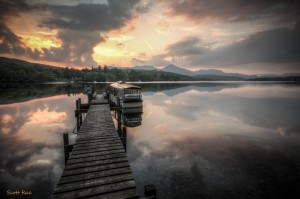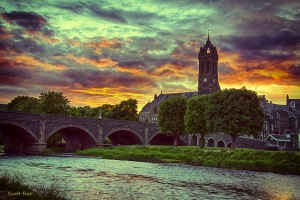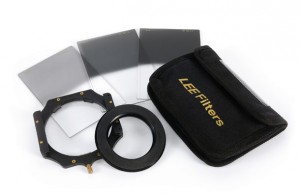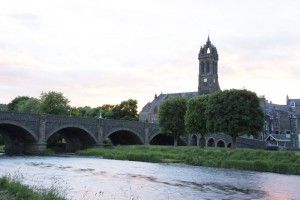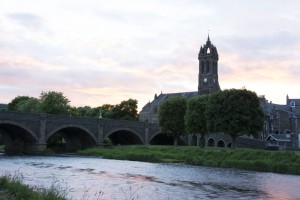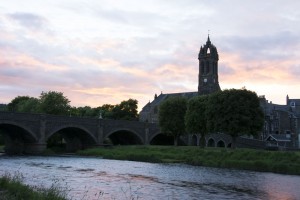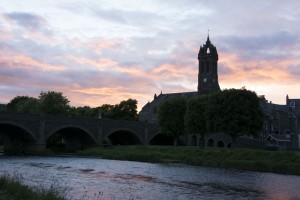Love it or Hate it – HDR Images
Love it or Hate it – HDR images can help overcome the limitations that all cameras have around their sensitivity to light and their ability to handle high contrast scenes. I have 2 photos that seem to have attracted more attention than any of my others. One is of Coniston Water at Sunset, and the other one is sunset over Tweed Bridge and the Old Parish Church of Peebles. These are very different images, but the one thing they have in common is that they are both High Dynamic Range, or HDR photos.
Unlike the human eye, cameras can only record a limited range of brightness before either the lightest parts of the image (highlights, the sun, the sky) become pure white, or the darkest parts (the shadows) pure black. In bright, high contrast scenes, A camera can normally be set to properly record one of these extremes, but it can be impossible to do both. Photographers of old would use graduated filters (below), which are darker at the top and clear at the bottom, to help lower the brightness of the highlights (usually the sky) in the image closer to that of the darker areas, meaning that the whole image was then within the sensitivity range of the film, or camera sensor. A drawback with a graduated filter though is that very few landscapes have straight lines in them, so particularly in hilly scenes, you’d end up with darker hilltops than valleys, where you had to place the graduation to make the sky darker. It became a bit of an artform knowing where to place the graduation! Grad filters are also expensive!
Then digital imaging and digital photography came along… Being able to computerise an image made it a lot easier to manipulate and make changes to images to help compensate for some of these old camera and film limitations (and in fact ignite a whole creative industry manipulating and changing photos to compensate for many other things, allowing new tools and techniques to be invented, and completely destroying the old truth that the camera never lies!)
HDR is one of the techniques that has been created out of digital photography. I personally find it an interesting tool that, if used properly, can produce images that better represent what your eyes (amazing optical devices connected to a supercomputer brain that see in HDR – and more! – by default) would have seen, but that the camera is incapable of capturing in a single image. A photographer will shoot a series of photos of a scene, each with a different exposure (usually increasing or decreasing the shutter speed for each image) so that, within the series, you’ve captured the brightest and darkest parts of the image, as well as everything in between. These images can then be combined in software to create a single image covering the entire dynamic range / brightness in the scene.
Here are the 4 images that went into making up the Parish Church HDR photo. You can see that the images on the left have too bright a sky but the trees, grass, bridge and church are perfectly exposed. The images on the right have shadows that are too dark, but you can see the colour in the sky that made the sunset so lovely. You can see that, if you could merge all of these photos together, you’d get something nice. However, I bet you’re looking at these photos and thinking “well they’re pretty average, aren’t they!” and I think you’d be right! More of that in a minute…
Once you’ve merged the images, the software lets you tweak the final image. It’s this manipulation that can make or break an HDR photo, and is what makes HDR such a “marmite” technique amongst photographers. Many people don’t like HDR as so many photos they’ve seen have been over-processed so as to look unrealistic, over saturated and containing ghosts, halos and artefacts that detract from the actual scene. But then some scenes can benefit from more extreme processing – particularly industrial landscapes. In terms of the Peebles image, well you can see I had a bit of fun with the processing!
My Coniston sunset and Peebles sunset were my first real experiments in HDR, with the Coniston sunset having the technique applied far more subtly than the Peebles sunset, partly due to the fact the Coniston sunset had far less contrast between light and dark than the Peebles sunset. In fact, as I found out later, I didn’t need to use HDR in the Coniston sunset as there was enough dynamic range in one photo (it wasn’t too light or too dark) that I could create an almost identical photo without using HDR. The original is on the left, and the resulting image is on the right. I could never have done that with the Peebles photo though!
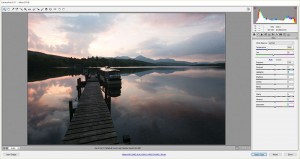
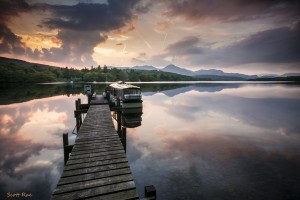
You can see that the Coniston HDR image processing is a lot more natural than with the Peebles photo, although you’re probably still wondering how it’s possible to turn the image on the left into the image on the right! The answer is, it’s possible to use the software to add a grad filter! It’s another tool in the toolbox than can compensate for lack of expensive equipment, but you’ve got to have an image with enough light data in it to work with. In this case, I did!
Now this leads us on nicely to another thorny subject: Post processing – cheating or not? Maybe I’ll leave that for another day though! 🙂
I hope you’ve found this interesting, and I’d love to hear your thoughts!
Have a look at some more HDR images over on Flickr: HDR Images on Flickr

